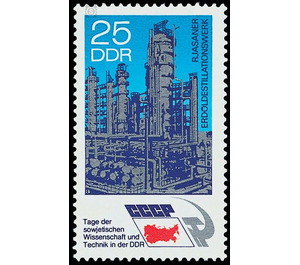Days of Soviet science and technology in the GDR - Germany / German Democratic Republic 1973 - 25 Pfennig
Theme: Economy & Industry
| Country | Germany / German Democratic Republic |
| Issue Date | 1973 |
| Face Value | 25.00 |
| Color | blue |
| Perforation | K 14 |
| Printing Type | Rotogravure 2 |
| Stamp Type | Postage stamp |
| Item Type | Stamp |
| Chronological Issue Number | 1631 |
| Chronological Chapter | GER-DDR |
| SID | 103851 |
| In 14 Wishlists | |
Days of Soviet Science and Technology in the GDR During the days of Soviet science and technology in the GDR, the Ministry of Posts and Telecommunications of the German Democratic Republic issued three multicolored special postage stamps. Days of Soviet Science and Technology in the GDR On October 29, 1973, the "Days of Soviet Science and Technology" begin in the GDR. Until 18 November 1973, domestic and foreign visitors will be able to convince themselves of the efficiency and high level of development of Soviet science and technology, giving experts and scientists the opportunity to present and exchange the latest findings in their fields of expertise. Of most interest to the public and the experts at the same time is the exhibition in the capital of the GDR Berlin in the Werner-Seelenbinder-Halle. Here, on nearly 11,000 square meters of exhibition space, top products of the Soviet economy will be on display, a range of exhibits ranging from synthetic diamonds, mechanical engineering and electronics to the mighty spacecraft "Soyuz" 2. 25-pfennig value: Ryazan oil distillation plant In Czarist Russia oil was mined only around Grozny and Maikop, and in small quantities also in the Embra area. There was almost no chemical industry. In the years of successful socialist construction, especially after the Great Patriotic War, the production of "black gold" increased more than thirty times. Today, in the Russian Federation Soviet Republic alone, 248 million tons of oil are produced annually. Twice as much as in the USA. In the Bashkir and Tatar Autonomous Soviet Socialist Republics, the "second Baku" was born. There, the performance of the traditional oil center on the Caspian Sea is being surpassed many times over. From the Ural-Volga region, the longest oil pipelines in the world lead to Lake Baikal in the Far East, connecting the friendly countries of the socialist camp Poland, Hungary, Czechoslovakia, GDR and provide them with the vital raw material. Through pipelines, the oil flows from the deposits to large oil processing plants in the northwest, the center, the south and in Belorussia. Kirishi, Novo-Yaroslavsky and Volgograd are among the highly productive plants of Soviet petroleum chemistry. In Ryazan, known as the center of mechanical engineering in the heart of the Russian Federation, Europe's most modern and largest oil distillation plant was built. The purpose of these far-sighted investments is to broaden the raw material base of Soviet industry; to ensure the continuous growth of the economy by increasing the production of petrochemical products by 50 percent and further quality improvements in the perspective period 1971 to 1975.


